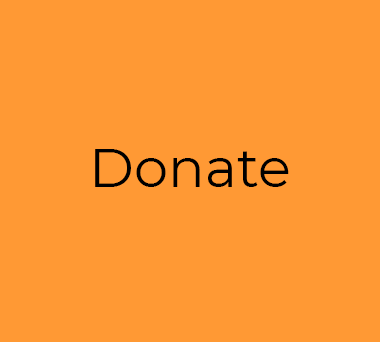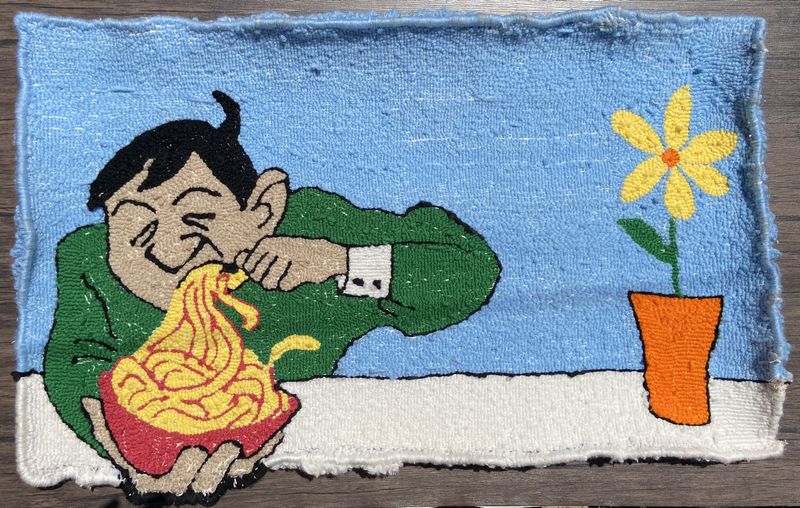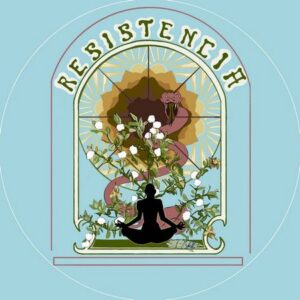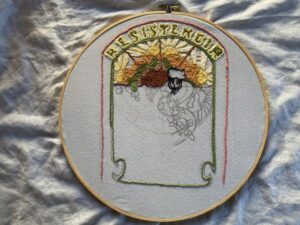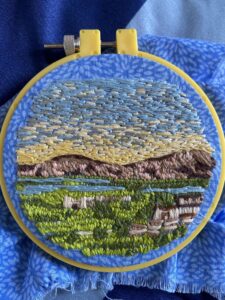2022 Chihuahuan Desert Cultural Fellowship Feature: Crys Ganatra
Michelle E. Carreon, Food Justice Storyteller
Crys Ganatra is a textile and visual artist currently based in El Paso, TX and one of the members of the second cohort of La Semilla’s Chihuahuan Desert Cultural Fellowship. Not wanting to limit herself to a particular place, she is an artist deeply committed to community and creating a sense of “home” wherever she goes.
Crys has shared that she has always been drawn to the arts, especially craftsmanship. From a young age, her work focused on “observational, realism pencil and painting drawings and portraiture.” Since moving to the Paso del Norte region and taking part in this fellowship, her work has become increasingly connected to the Chihuahuan Desert ecosystem and its native plants. During the fellowship, she has been conducting interviews with local experts about various native plants and is weaving a series of embroidered designs reflecting these stories and folks’ connections to the desert ecosystem.
We sat down with Crys during the fellowship to learn more about her cultural practice, influences, and connections with the Chihuahuan Desert ecosystem. The following are excerpts from our conversation.
A Sense of Place and Home
It’s hard to answer where I am based, because there are only a few environments I grew close to and communities I considered family within those environments. In some part, I don’t want to limit myself to a particular place or people. I’ve just found “home” to mean more where I feel at home, and where I feel at home is the community I’m around, where I can be completely myself. The closest I can get to as a base right now would be El Paso. It’s just an amazing community here. People who share similar values to me. I think that goes hand in hand with political values and political views. You go somewhere, and there’s not too many steps away from someone you know. So the farm that I go to, [La Mujer Obrera’s Tierra es Vida Community Farm], has volunteer days on Tuesday and Sundays. The same people you see there, you’ll see at a punk show at Galeria Lincoln or you’ll see at Cafe Mayapan. It’s not a small place, but, generally, if you are like-minded you’re going to [cross paths]. I really like that about a place.
 Traditionally, I guess I would say Alabama [is a home base]. That is where I was raised and went to school for most of my life. I am originally from the Madison/Huntsville area of Alabama. My mother is originally from Jamaica, and my dad is from India. They moved to the United States in the ’90s. One of my influences growing up was the Madison Public Library in Madison, Alabama. Some of the most wonderful people I’ve ever met worked there. The youth librarians were incredible, and hanging out and volunteering there immensely influenced “Baby Crys.” Hand in hand, books were highly influential to me too. They’re nothing like good storytelling and true community.
Traditionally, I guess I would say Alabama [is a home base]. That is where I was raised and went to school for most of my life. I am originally from the Madison/Huntsville area of Alabama. My mother is originally from Jamaica, and my dad is from India. They moved to the United States in the ’90s. One of my influences growing up was the Madison Public Library in Madison, Alabama. Some of the most wonderful people I’ve ever met worked there. The youth librarians were incredible, and hanging out and volunteering there immensely influenced “Baby Crys.” Hand in hand, books were highly influential to me too. They’re nothing like good storytelling and true community.
Before moving to El Paso, I visited a best friend of mine who lives in Las Cruces, New Mexico a few years ago. We did a bit of hiking and camping in El Paso in 2019. I really enjoyed my time visiting. I remember being in awe of the mountains. It was just so vastly different to any environment I had been in my whole life. Also, shortly after college, some more friends of mine that I’ve known for approximately six years now, decided to move to El Paso. They had been asking me to come and move in for about a year. So I took them up on their offer in March of last year. The rest is history.
Farming Experiences and Influences
One of my friends in Las Cruces did a La Semilla farming fellowship last year. I’ve known her for seven years now. We went to college together. She’s always been involved in that kind of thing and knew about Tierra es Vida. My first day at [Tierra es Vida], I remember, was a rainy and cooler day. We were doing some weeding, and Guillermo came by. He’s like a pillar of this community. We took a break, and he brought out his cafe de olla and his cute little pot. So that was my first day, and that was my first introduction to Tierra es Vida. I would go pretty much every Tuesday or so. Then, I learned more about La Mujer Obrera through working with [Juntos y Vacunados]. They got this grant to help people get vaccines. That’s how I started to understand more about the different aspects and connections of the organization.
When I was at college at Amherst, we had a college farm where students could do work-study. I did that for work-study and a summer internship. I really enjoyed it. It was the beginning of my gardening and farming experience. It was cool to see every process, from seed to harvest. The food was [grown] to feed the dining hall and the CSA program. There was a lot more land, and I think they had less say about what was being planted, because of what the dining hall would request. That was a difference, as well as the plants. You’re not going to see cempasuchil or anything like that around, like prickly pears. It was more plants that I had seen before, you know. Here it’s palo verde, which I had never seen before. The education process was different. I’d learn how to weed a certain way and what a brassica was, for example. Here it’s like, “you can eat this, this is what it’s called.” I was learning the different perspectives on [what we were growing]. Like, “this can be used as a salve or this could be made to dye things.” And of course the cold was different!
How would you describe your cultural practice?
I’ve never really thought about describing my practice. So it’s like, “what is it that I do,” you know? I’ve recognized a pattern in my practice, regardless of the medium. I gravitate towards work that is hands-on, detailed, community-oriented, and slow-paced. Most recently, my work delves into embroidery and weaving, and, with that, an expansion of my concept of community within my practice to the environment as well. When I look at my work, most of the things that I’ve done, post-graduation and the last couple of years, have been very gift-oriented. So, for example, my friends get married, and I do a portrait. They’re doing this part of their home, “let me make you a carpet.” So in that way it’s been community-oriented.
I want to capture the people who are important to me, and that, in itself, is community-oriented. Gift-giving is outside of yourself. There’s not a lot that I make for myself. Things I dedicate a lot of my time to are for others. I think I’ve always been that way. In school, I’d spend more time crafting than on homework. I just enjoy my art more for others, rather than just hanging it on a wall somewhere. Working with my hands feels fulfilling. Even food service work, like building sandwiches and odd jobs that I’ve done. That has felt more fulfilling to me. I don’t know if I can fully explain it, it just is.
I like slow work. Sitting down, putting on a podcast, and sewing something. I don’t like to be rushed, especially when this world is “produce, produce, produce.” You have to give so much of yourself. It’s very demanding, and it’s not the way it was supposed to be. So meditation and letting my practice be forgiving, time-wise, I think that’s important. Living in a capitalist country is very go, go go. I like to put emphasis on what slow work can do. Sitting down and getting to know each other’s stories is valuable if you don’t have a thing to put on it. Not containing in that way is important.
How do you connect with the Chihuahuan Desert ecosystem and border region through your cultural work and other ways?
Through my cultural work, I’ve been doing detailed studies on native plants in the Chihuahuan Desert. This has included one-on-one personal interviews with plant specialists within my already-known and loved community, as well as personal research from the Internet. During these interactions and consistent knowledge gathering, I’ve heard personal stories of how these native plants have impacted lives. I’ve transformed one story already into a detailed digital design that I am now meticulously embroidering.
Other ways I have connected with the ecosystem and border region include volunteering at Tierra Es Vida Community Farm, [the fellowship] monthly/bi-monthly cohort meetings, hiking, going for walks in my neighborhood, and spending time with native El Pasoan friends who’ve experienced the border and larger ecosystem their whole lives.
Going for walks is something I used to do a lot as a little kid, and I think that’s kind of telling. I think connecting to the environment is also like connecting to your inner child. The part of nature that you are when you slow down is more apparent. If I am extremely anxious or I have a lot on my plate, I think, “Why didn’t I just go on a walk?” Seeing plants around here and going on walks with friends returns it to home. It’s different from walking along a bunch of manicured lawns. That’s what I also find special about El Paso–the more acceptance of native plants around here. It seems like more of an appreciation of a native ecosystem than just a plowing down of what is there.
In what ways is your cultural practice intergenerational?
I don’t know if my cultural practice is exactly intergenerational, but I do see patterns of a thread connecting me to my family. One of my cousins is an opera singer. It’s a creative family. My sister plays piano, my brother plays guitar. My grandmother on my mother’s side used to be a seamstress, and my great aunt who lives in Minnesota, besides being an incredible cook, is a very talented seamstress. I guess we all have valued working with our hands and textile point at some point. I know that embroidery work has a history of being reserved as a recreational flex for upper-class white women, but it also has a strong tradition for POC, as well, in visual storytelling. It’s cool that I can see elements of that in both my and my family’s artistic work.
What does this fellowship mean for you and your work?
This fellowship has helped me meet really cool and talented local artists I never would have met before. It’s opened up these beautiful spaces of vulnerability and storytelling. Each group session leaves me feeling such a deep tenderness, wholesome, and gratefulness to be a part of such a project. It’s internally prodded me to get into a rhythm of letting down my own walls more and approach spaces with more ready openness like my peers/cohort members. It has also provided me with some more financial stability, expanded my portfolio, and given me a structure to check in and build a passionate longer-term project. It’s pushed me to connect my community and environment’s stories deeper into my textile cultural practice.
I really liked the workshop that Lupe [from Community Education] gave. I was so hungry and was eating as I was learning stuff. It was delicious! We made the little tortillas and cactus. We ate a bit and then did more storytelling with Lupe and told stories about food. There are always tears (haha) just about food. People would talk about growing up and the intuitive knowledge of cooking and where that comes from. Just thinking about my own relationship to cooking and how baby that is. I grew up eating Indian food mostly because of my dad. Every once in a while we ate Jamaican food. Reliving that and thinking about what I learned when I was younger and how it impacted my life. [The workshop] was special.
It’s like a mini different world when we have the cohort meetups. My friend who was in the farmer fellowship mentioned it being like a “vulnerability hangover.” I wish it was like that more outside of the fellowship. What are ways we can create those spaces without a small curated structure? I want more. I’m a little shy, so I listen more than I talk. It has challenged me to share more about how I feel. Even applying to this fellowship, I felt like “I’m not a native of El Paso…I’m just some schmuck that came out here.” I know I can’t talk about myself like that, but I just don’t have as much direct history to this place. And yet I still feel a connection in this group. So both of those experiences can co-exist. Mostly I just feel honored to be a part of it. Many other people would benefit from this experience, too. I just feel gratitude. It has been fun and keeps me going on this project. I feel like it’s a lot deeper now, as I integrate interviews and researching these plants literally around me. The art I’m creating feels more meaningful. This is another way I can approach art-making and sharing in community.
Which Chihuahuan Desert plans would you like to learn more about and/or like for others to know more about?
I wish folks would know more about the False Rose of Jericho (also known as resurrection plant), gobernadora, and ocotillo plants. I also would like to keep learning more about them and the stories about them. Like the False Rose of Jericho seems biblical in nature. I grew up Christian, so I’m curious about where that comes from. These are the plants where my embroidery is taking me right now.
All photos provided by Crys Ganatra.

